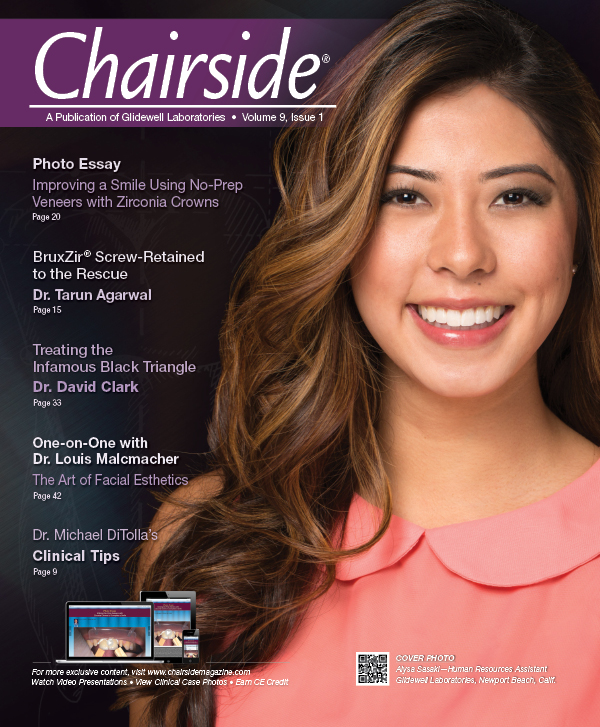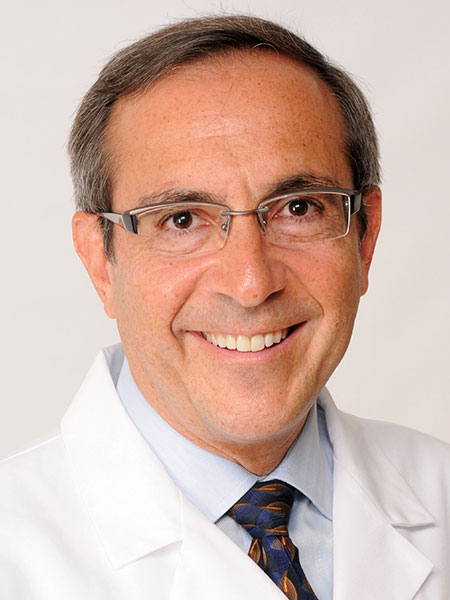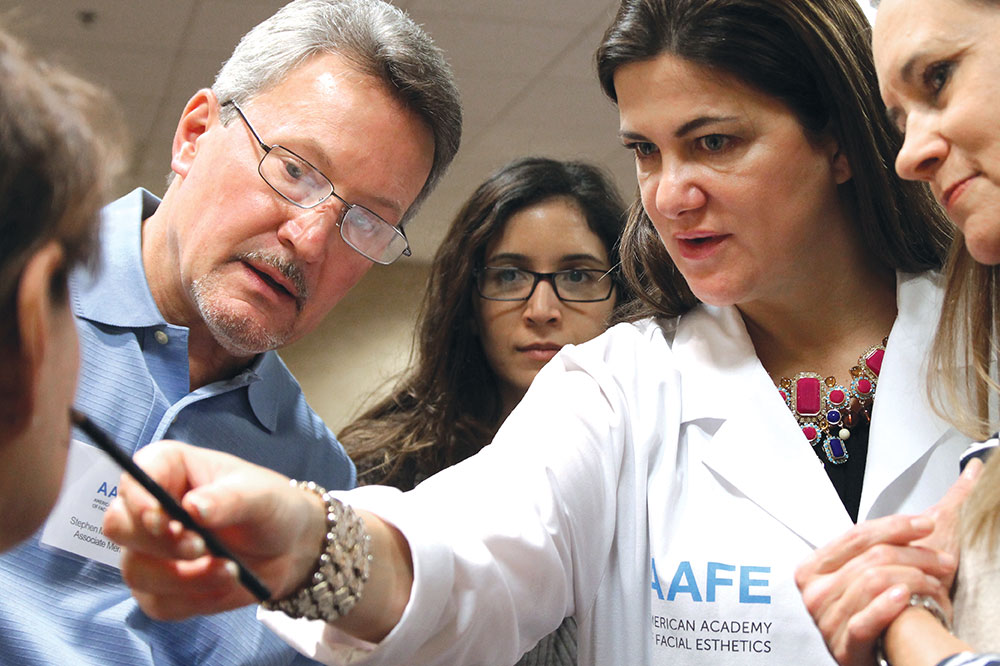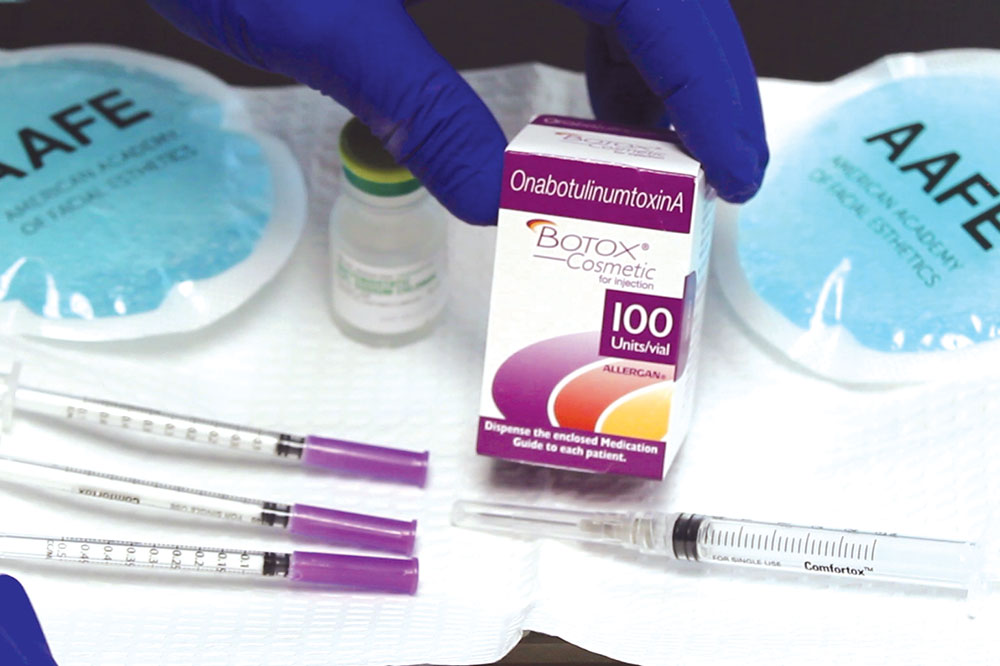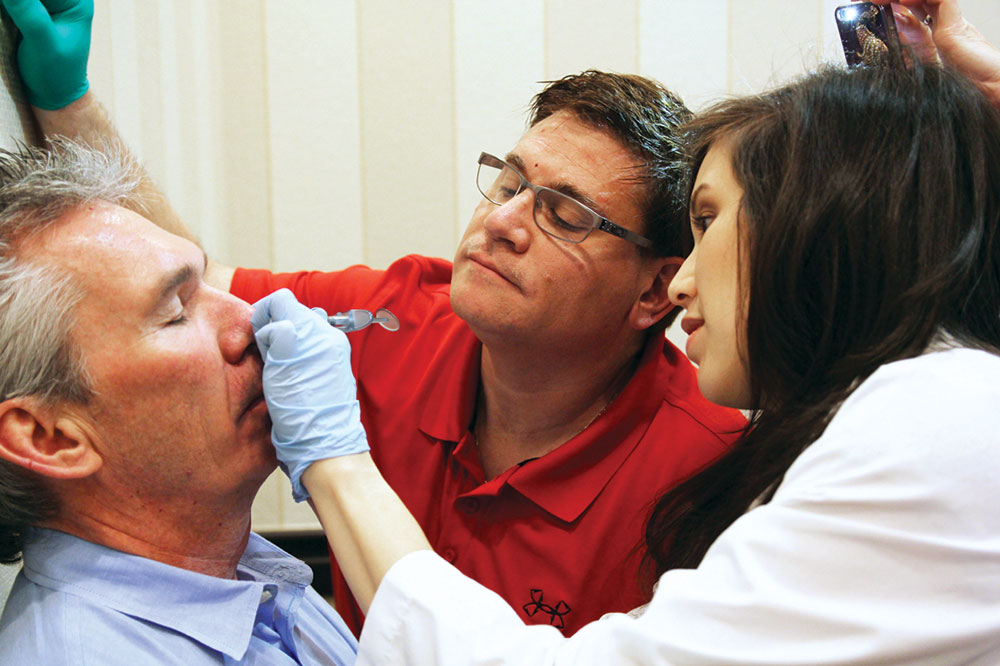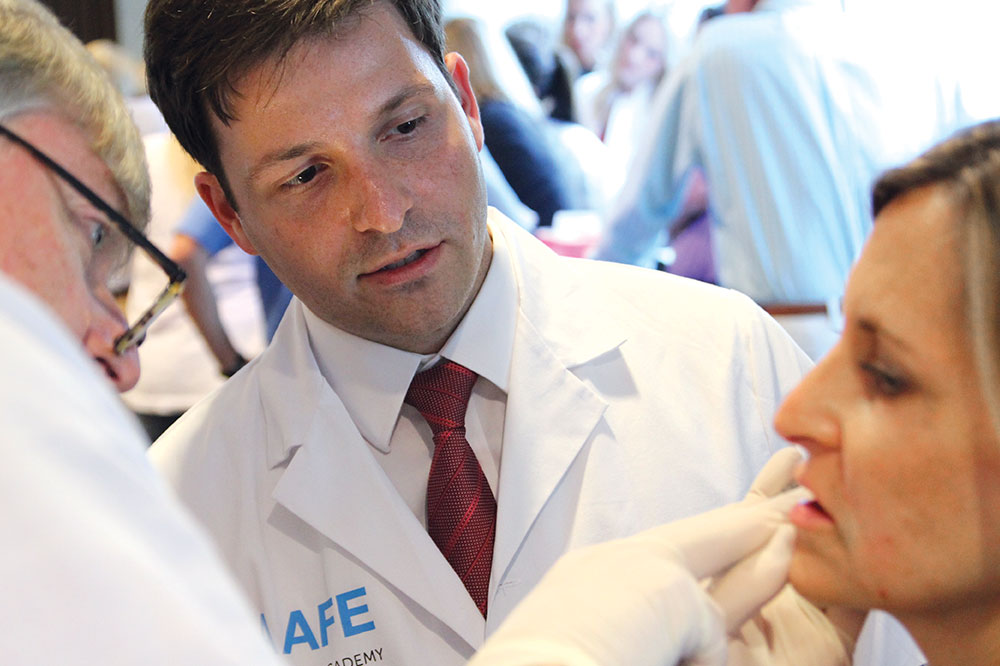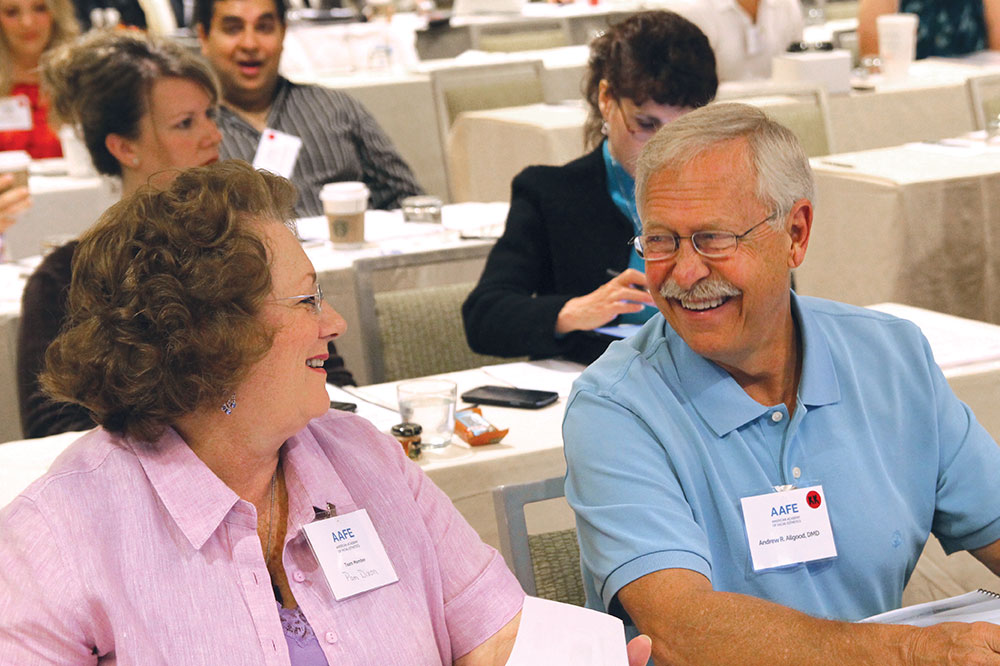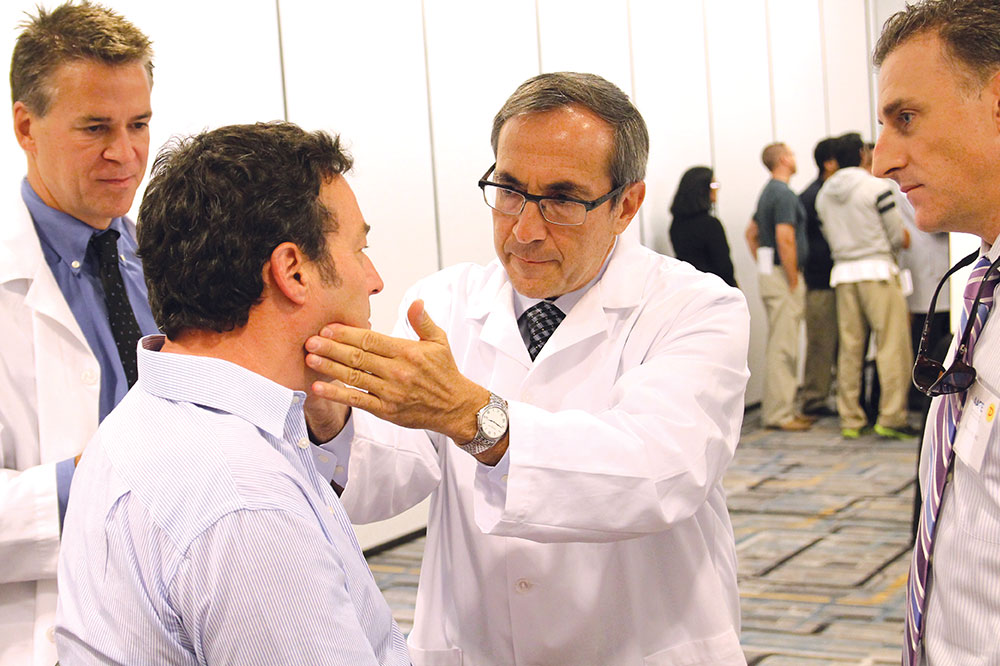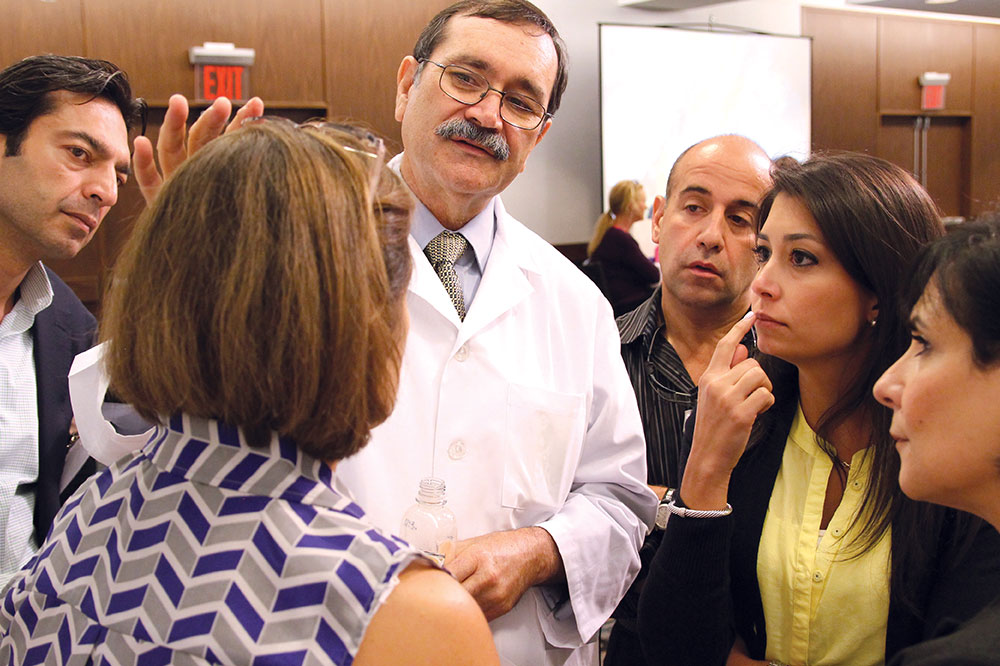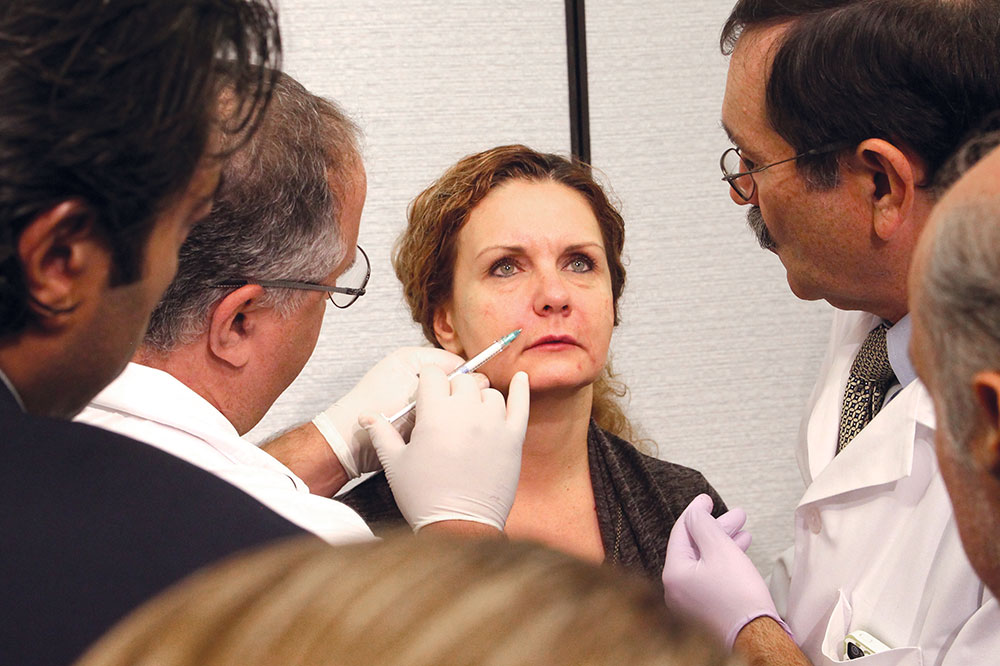One-on-One with Dr. Michael DiTolla: Interview with Dr. Louis Malcmacher
Dr. Louis Malcmacher is an internationally renowned lecturer and author who maintains a private dental practice in Cleveland, Ohio, with a focus on esthetics, facial pain and dental sleep medicine. He is also the president of the American Academy of Facial Esthetics (AAFE), which is the premier dental educational organization with over 8,000 members and over 300 course days a year in the areas of dental/facial esthetics, orofacial pain, dental sleep medicine and bruxism therapy. If you’ve been paying attention at all to what you see in the dental journals and emails that circulate, you’ve likely realized that there are some new hot topics coming across our desks, including using BOTOX® (Allergan Inc.; Irvine, Calif.) in dentistry. An old friend of mine, Louis is a leader in the field of facial esthetics who is intent on educating general dentists about less invasive procedures that still provide the outcome patients are looking for.
Dr. Michael DiTolla: How are you doing today, Louis?
Dr. Louis Malcmacher: I’m doing great.
MD: We’ve known each other for a long time.
LM: A very long time.
MD: We’ve crossed paths several times lecturing, but this is the first opportunity we’ve actually had to sit down and do something in a little longer form. So I want to ask you the question I’ve been meaning to ask you for over a decade: What nationality is Malcmacher? It sounds Swedish to me.
LM: Swedish? No, you don’t have a good ear for languages.
MD: Hold on. Mongolian?
LM: You’re getting closer. No, not really. It is German. It is actually really interesting. "Macher," whenever you see it as a part of any name, means "maker," and "maltz," which is the way you pronounce it in German, means "beer malt." We have come from a family of beer malt makers. I can drink it, but I can’t make it.
MD: OK. So it would be pronounced "malts."
LM: Right. Actually, if you say it the right way, it’s Maltzmacher; but everyone asks me, "How do I introduce you?" And I say: "Just call me Louie. I’m a general dentist. Just call me Louie."
MD: The thing I associate with you the most is the AAFE, the American Academy of Facial Esthetics. Tell me a little bit about how you were introduced to this type of dentistry and what was behind you starting up an organization like the AAFE.
LM: It’s interesting, the whole area of facial esthetics. To a certain extent, when you and I were starting in dentistry, esthetic dentistry was really coming into its own. When you think back to those times, dentists were saying: "No, we’re into form and function and pain. We’re not cosmetologists, we’re not hairdressers or anything like that." We always thought of esthetic dentistry as being in the mouth. Now, in the last few years, facial esthetics has come with dentistry, highlighting the importance of pharmaceuticals such as BOTOX and dermal fillers, and what they really mean and how they apply to dentistry.
The way I got into this was interesting. I’m in private practice in Cleveland, Ohio, where we have a great group practice with a number of offices. Something came across my desk from the Ohio Board of Dentistry, stating that dentists can now do BOTOX and dermal fillers as long as they stay within their scope of practice — which in dentistry is most of the head and neck — and I really wasn’t that interested in it. My wife saw it, too. She’s not a dentist, but she is a consumer, and she is a patient, and she said, "You better go learn about this." I said, "Why?" And she said, "It will save you money." Well, that got my attention, because I’m cheap; I’m looking to save money. But as I really examined it, I saw the potential of this in dentistry.
People get hung up with BOTOX: "Should dentists really be doing BOTOX?" and those kinds of things. BOTOX and dermal fillers are just pharmaceuticals. They’re no different than lidocaine. They’re no different than antibiotics or anything else that you would use on a patient. As long as you use it within your scope of dentistry, then it is dentistry. The ADA’s definition of dentistry in most states includes jaws, teeth, associated structures, head, neck, and the entire oral and maxillofacial areas. What we’ve been doing in dentistry is ripping all of the teeth out of the mouth, putting veneers on patients, putting them back in the mouth and telling patients, "You’ve got a great-looking smile." I mean, that’s fantastic. They could have thin, little, deficient lips; they could have regular lip lines; they could have deep folds; the rest of their face could be falling apart; and at the end of that, the dentist says, "You’ve got a great smile, because I did all of your 28 teeth."
MD: We’ve routinely had to reject cases here at the lab where we want to have a stunning before-and-after. We’re always looking for a supermodel with really messed-up teeth, but you don’t often find that. You’ll find someone with messed-up teeth, but you realize that this is not going to be a great actor, because when this person smiles, you’re right: Either the lips are going to be very deficient, or there’s going to be a gummy smile. And almost any dentist watching is going to go: "Eh. That turned out OK." But it’s not going to be that kind of "wow" factor that we get.
I always think about orthodontics. Orthodontics has been a specialty for over four decades, and orthodontists were, in my mind, the first people doing cosmetic dentistry; and doing a very conservative version of it, too. Every week, we hire 10–15 employees here, and we have them smile and we take a closeup picture. I can always tell immediately who was born in the United States and who wasn’t, because those with straight teeth had ortho and were born here. Those who weren’t born here, you can see all of these rotations and alignment issues. So I feel that esthetic dentistry is ingrained in the American psyche. (In fact, you’re probably labeled a bad parent today if your kids don’t have orthodontics; Social Services might take them away.)
So if these are just medicaments not that much different than lidocaine, I don’t think any other professional has as much experience or knowledge on giving injections in and around the mouth area, or the head and neck area, as we do. We are, somewhat by default, the experts in this, aren’t we?
LM: Absolutely. And this is exactly what we found, and the AAFE was founded once I saw what we could accomplish. Number one: The truth of the matter is, as you just pointed out, dentists are by far the best injectors. And we’re holding trainings. We have over 300 programs a year with live-patient training. Number two: It turns out dentists give the most injections of any health care professional, and they give them right in the facial area. So we’re not talking about dentists giving BOTOX in the hands or underarms or those kinds of places; we’re talking about dentists giving injections within the scope of their practice. Physicians barely give injections; they delegate to nurses, and certainly nurses don’t give most of their injections in the face. Dentists are more familiar with the process, so it’s much easier to train dental professionals. They only have to learn extraoral injections.
MD: I would rather have a dentist inject me than a neurologist or a podiatrist! Let’s start off with the facial pain and TMJ aspects of BOTOX, because that seems to be an area where many state boards don’t have an issue.
The use of BOTOX and dermal fillers started off with esthetics, and then moved elsewhere. … What we really found is that dental esthetics is facial esthetics, and vice versa.
LM: The use of BOTOX and dermal fillers started off with esthetics, and then moved elsewhere. You always wanted to find a supermodel with really bad teeth for your clinical cases? What we really found is that dental esthetics is facial esthetics, and vice versa. You can have this gorgeous set of teeth, but if you don’t have the surrounding face to support it, it doesn’t look that good. If you have a supermodel, and when she opens her mouth, she’s got these ugly little yellow teeth, that’s not going to look good either. We missed the boat in thinking that dental esthetics is not really a part of facial esthetics. We started with BOTOX and fillers because, literally, a lot of dentists were coming because their wives or their team members were pushing them out of the office as soon as they found out that there was such a thing. They are the biggest beneficiaries, because ours are live patient courses, so participants have to bring a model. We always want them to bring a model, because they’ve got to go home and live with that model, so if they don’t do a good job, they’re going to know about it.
MD: Meanwhile for every other course, the dentist goes out and takes the course and comes back, and the staff is like, "If we ignore him long enough, he’ll forget about this, and we won’t have to start incorporating orthodontics." This must be the exact opposite. They come back, and at 8 a.m. on Monday, "Let’s do this!" And he’s like, "I’m not quite ready." And they say, "Shut up and shoot me now!"
LM: That’s exactly right. First of all, they all want to come to the course. A dentist called me up, and she was whispering into the phone, asking about BOTOX and whether she could use it in her office, and whether she should take a course about it. I asked, "Why are you whispering?" She said, "Because if my team hears that I’m talking to you about a BOTOX course, they are going to push me out the door." Your office team is your average consumer. They’re telling you what your patients want from all of this.
We had one dentist come with his wife as a model patient. There were about 20 dentists around, and I was talking to the wife, just taking a quick, little medical history. I asked, "Have you ever had BOTOX before?" And she said, "Yeah." And he looked at her and said, "You have?" And she said, "Honey, I’ve been going for three years." So I asked her: "You’ve been going to the dermatologist: How often do you go? Every three to six months? How much do you pay?" She said, "I can’t tell you in front of him; he’s going to kill me." He was a really nice guy, so he said: "Honey, what’s the difference? Now we’re going to save all of this money." She said, "Every time I go, it’s $2,000 for 20 minutes." Well, he nearly dropped dead. It was hysterical. She turned to me and said, "How much are these courses?" I said, "They’re about $2,900 for two days." She started laughing and said: "That’s nothing. You guys are going to make your money back in no time. You have no idea what the potential is for that."
But that’s it. You’re going to save money. Everybody is getting older. BOTOX and dermal fillers are the most popular esthetic treatments in the world. In dentistry, we’re in our own little bubble. We think: "Oh, veneers! Oh, whitening is so popular!" They don’t even come close to the potential of this.
What else happens is people come in and say: "Yeah, I look great, but you know what? My headaches went away." I’ve been treating TMJ and orofacial pain for 35 years. Any dentist reading this knows that this is frustrating. We ignore these patients. Let’s be honest, we’re scared to death of them. They come in, they’re in pain, we give them a bruxism appliance saying, "This will fix you up." Three months later, they’re still complaining, so we fix their occlusion. Most of these patients don’t get better. BOTOX is not magic; you’ve got to understand how it works. But BOTOX is a treatment that, along with everything else, really gives patients a lot of relief quickly. The AAFE Frontline TMJ, Headache and Orofacial Pain live-patient training courses are as popular as the BOTOX and dermal filler live-patient courses. Doctors are interested in learning how to do trigger point injections, learning how to use BOTOX, lidocaine, and different kinds of things that have been around for 40 years. In dentistry, we’ve just been really slow to accept them. And this kind of pain management is taught in every dental university orofacial pain residency. That’s what’s crazy. It’s not unknown in dentistry; dentists need to get trained.
MD: But I can think back over 25 years of being in practice, and looking at the courses being offered at the CDA, it wasn’t often that I was saying, "Should I go to the veneer class or the trigger point injection class?" It’s not like it’s been out in the forefront until you put it there.
LM: The AAFE faculty is the best out there in all of these areas, and our members are incredible in learning these techniques and integrating them immediately into their practices. The truth of the matter is, we teach how to do a really good muscle evaluation in our frontline TMJ and facial pain classes. Most instances of orofacial pain are caused by muscles. Talk to Dr. Henry Gremillion, who is the dean of the LSU School of Dentistry and an orofacial pain specialist. One of the first slides he puts up is that 85% of orofacial pain comes from muscles. I have about 59 pages of evidence-based dental research talking about muscle pathology in orofacial pain that has nothing to do with the teeth or occlusion. We’ve got to hack this idea that occlusion and muscles are connected, and the pain is only coming from the occlusion. That’s baloney. Go for the muscles first. It’s non-surgical, minimally invasive, reversible, and it’s easy to accomplish for any dental clinician once they have been trained properly.
MD: And even if it’s not evidence-based — and you say that you have 59 pages that it is — what’s the harm in starting with the muscles before we go into a full-mouth reconstruction on somebody? We should do something that is reversible and less invasive, rather than going in and knocking all of the enamel off of the teeth and rebuilding the whole dentition in zirconia.
LM: If 85% of orofacial pain comes from muscles, then treat the muscles first. In dentistry, what we do when a patient comes in with pain is, we say: "Here’s a bruxism appliance. Go home for three months and wear this, and let’s see if this helps you. Come back in three months." I don’t know about you, but if you go to a doctor when you’re in pain, when do you want to get out of pain?
MD: Yesterday.
LM: Right, like now. Only in the dental office is "We’ll see you in three months" acceptable. And then when the appliance doesn’t work? I’ll tell one thing to all of the occlusion aficionados and everybody else: There is so much occlusion confusion out there. I use that term all of the time, and everybody can relate to it because nobody knows what the heck to do. After 150 years of occlusion, still nobody knows what the heck to do or where it really should be, and we’re unable to agree on what the right thing is. First of all, get the muscles out of pain. If BOTOX gets them out of pain, then do your occlusal calibration after that. You will be shocked at how easy the occlusal calibration is because the muscles are relaxed. Now you can go ahead and really put things where they are. With the muscles relaxed, I can do everything else a lot easier.
Can you imagine taking a patient through the worst-case scenario? Orthodontic surgery and full-mouth reconstruction, and then you’re three years down the line and upwards of $50,000 later, and they still have some pain? Maybe not all of the pain, but they still have some pain. That’s a scenario just about everybody reading this has been through if they have treated any kind of TMJ or orofacial pain. I remember that. I don’t care where you were trained. It’s awfully frustrating for everybody. I mean, we know the messy cases where they’re breaking teeth. I see that in my private practice all of the time, these people that have gone through all of this treatment — and not just in dentistry, but also in medicine — and I do a couple of trigger point injections and spray them a couple of times with ethyl chloride, and they say: "My pain is gone. No one has ever done this to me before."
MD: So they notice immediate relief from those trigger point injections?
LM: To all of the dentists who think this pain is just occlusion-based, you’d be amazed at how many patients are going to get out of pain with this treatment. There are only 300 orofacial pain specialists in the United States. There are a lot more people in the United States than those 300 could actually handle, so I want to give every dentist the basic frontline skills of how to treat these patients. With this treatment, the patient’s relief is immediate or a couple of days in. If it’s not, then we know that it’s not muscle-related, and that’s an important point.
MD: I can see a dentist saying, "Well, it all sounds great, but I don’t think I have any of these patients in my practice." I remember putting a question on my health history years ago that read: "If there was a simple, non-surgical way to stop your spouse from snoring, would you be interested?" And of every 10 women who read that question, eight of them put, "Yes!" And the other two put: "I don’t even care if it is surgical. I don’t care if you pour concrete down his larynx. I don’t care what you have to do, just stop the madness." Is there a question that you could put on your health history to start to see if you do have these kinds of people in your practice?
LM: Absolutely. We have the question. It’s called "headache and migraine." Dentists have it on their health history. The problem is that when patients check off "headache and migraine," dentists just ignore it. You need to know how to diagnose it. You can diagnose it as well as any condition.
I also ask questions on the health history from the esthetic standpoint, because this can be very substantial. Put the question on your health history asking if the patient has ever had BOTOX or dermal fillers before. You will be amazed at the number of people who say, "Yes." When I first started doing this, what was really frustrating was the number of people who would say, "Yes," and they had been walking around with a broken tooth for three years, telling me they didn’t have the money, but they were going out and getting BOTOX and dermal fillers.
The reason why that is important to a dentist is that BOTOX and dermal fillers are both temporary treatments. BOTOX only lasts three months; dermal fillers last six months. For an esthetic example, Glidewell Laboratories does a great case for its marketing materials: a case of 10 veneers that were put on. You’ve evaluated the smile lines and the lip lines after you put these veneers on, and when the patient goes into a full smile, the bottom of their upper lip should just ride the central incisor margins. An ideal esthetic case, right? Not too gummy, and you’re not hiding teeth. The lip line is exactly where it should be. So, let’s say you have a female patient who comes in and says she went to the dermatologist a month ago, and she had some dermal fillers put in her lips to enhance her lips. You now are finishing your dental esthetic case to where you think, "Oh, this is a great bottom-of-the-lip line." But that lip is actually artificial. That lip disappears in three to four months because the dermal fillers fade, and she has a gummy smile now. Of course, everything is always the dentist’s fault. We all know that.
MD: I knew those lips were fake!
These are five- to 15-minute appointments, and the fees are typically very high: A little case is $500, a big case is $3,000, and you’re done in 15–20 minutes.
LM: Right. And we never asked the question because we didn’t know any of that. But now that dermal fillers are in dentistry, not only do we know to ask the question, but we also know how to control the entire situation. And that’s really beautiful. There’s not a veneer case where I won’t give a little bit of BOTOX and dermal fillers for free. This way I’m showing the patient how just having a little bit of an enhanced lip is really going to make this case shine. And they fall in love with it.
MD: When you look at what we’ve done in terms of crown lengthening surgery, there’s a lot involved to get rid of that gummy smile. It sounds like you guys have a way of conservatively dealing with a gummy smile, and it might entail you seeing the patient twice a year to maintain that look. How are you able to deal with something like that with the use of BOTOX and dermal fillers?
LM: You have to remember that our moral, ethical and legal obligation to the patient is to give them all of the available legal treatment options. So if you’ve got a gummy smile, you can do orthodontics, you can do orthognathic surgery, you can do crown lengthening and a gingivectomy; then you’re going to put veneers on and those kinds of options. But you still haven’t quite met the lip, or you still have some room there, and that can be frustrating. BOTOX affects muscles. With a little bit of BOTOX in the upper lip elevator muscles, just to relax them and bring the upper lip down a little bit, and a little filler in the lips, I can get rid of most gummy smiles in about 20 minutes. Again, this is an offer to the patient; I’m not advocating. In my office, I’ll do the crown lengthening, just like you do. It’s what’s available to the patient. What does the patient want? Many times, with BOTOX to relax the upper lip muscles and lower the lip a little bit, and a little bit of filler in the lips or fillers in this part of the face, in 15–20 minutes, I can very conservatively and minimally invasively get rid of that same gummy smile. I’m talking about some of the serious gummy smiles that you see and that many dentists don’t want to touch.
MD: Not just a millimeter or two?
LM: No. I’m talking about the 10 millimeter cases. We can make a significant improvement. And the patient may like the BOTOX and fillers treatment and only want to do that. It’s continued production, and that’s OK. What’s happened a lot of times is I’ve done a gummy smile case with BOTOX and fillers, and that gave patients a preview of what I was talking about with the dentistry, because they don’t want to commit to $15,000 and a lot of surgery. We can keep doing the BOTOX and fillers every three to six months, or they can have the surgery done once and be done with it. But now, you’ve given them a chance to look at the options.
I also tell dentists that giving extraoral injections is easy: You just have to follow the muscles. You’ve got to know the anatomy, and the rules of injections and how to do the sterile technique, but it’s among the simplest dentistry you’re ever going to do. I tell dentists — half-jokingly, but the truth of the matter is it’s real — it’ll be the first time that you can actually see what you’re doing. Because we work in this little cave. And I don’t care how much light you’ve got, or how many hands you’ve got in there: a second molar? We’ve never really seen it. We’ve felt the crown prep. This is an open canvas. Once you understand the anatomy and how things work, it’s easy to give these injections. These are five- to 15-minute appointments, and the fees are typically very high: A little case is $500, a big case is $3,000, and you’re done in 15–20 minutes. The patient actually says, "Thank you," and loves you because they’re getting BOTOX and fillers, or you’re getting them out of pain, or both. It’s something that makes you look good and feel good. What else do we have like that in dentistry?
MD: Is one of the sticking points going from intraoral injections to extraoral? Because I’ve lived a sheltered life, and I’ve only given one extraoral injection in my career, and it was by mistake: I turned and the patient turned, and I gave it by mistake. Of course I didn’t charge for it either.
LM: It’s not a big sticking point, and dentists get over that after a couple of extraoral injections, because they give so many injections. It’s a different experience, going into mucous membrane which you glide through easily, versus going through skin, which is a little bit tougher. A dentist will get over that in about 10 seconds. Then BOTOX will take two to 10 days to kick in. But then it will last for about three months. Dermal fillers are plumpers. I inject the area around the nasolabial folds and lips; that actually fills it up right away. That will last for about six months.
MD: You mentioned a gummy smile case where you could relax the lip a bit with BOTOX. So the filler actually has some weight to it that will pull the lip down?
LM: The filler will just make it look bigger and will hide the gum. That’s it. The BOTOX will relax the upper lip elevators so that the lip falls down a little bit. That’s why training is so important. If you know the anatomy and have some live-patient training, then it’s really easy. If you put a little bit of BOTOX in these lip elevators, which keep the upper lip up in a gummy smile case, you’ve got to know how much is necessary. We’ve got a protocol that we use, and we actually take measurements for how far the gingival margin is to the bottom of the upper lip and how much BOTOX to use. And we’ve done that on thousands of patients, and we’ve kept records over the last few years, and that’s really helped dentists. But if you don’t know what you’re doing, and you put in too much BOTOX, the patient’s upper lip is around their knees. And they’re not very happy.
The thing about BOTOX is it’s very precise, and right up general dentists’ alley. You would not believe the people that take our courses: endodontists, periodontists, orthodontists. Oral surgeons, obviously. Why not? Endodontists for pain and periodontists for pain. They all want to add BOTOX and dermal fillers to their practice, since it’s another income stream for their office. It’s so popular. The funny thing is patients already think dentists do BOTOX. Why? Because everybody does BOTOX. Every nurse on every corner does BOTOX. It’s so common, it’s almost as common as getting your teeth cleaned. As a matter of fact, we found the patients love coming to dentists for BOTOX and fillers because they’re sitting in the dental waiting room with their friends, but nobody knows what they’re getting. There’s a certain amount of anonymity they like. You sit in a dermatology waiting room, and everybody knows that you’re getting shot up. Consumers already think dentists do BOTOX, because they have us on a pretty high plane in terms of health care professionals. With dentists, unfortunately, our own self-esteem is like, "Oh, I’m not a real doctor." And I think that’s part of the pull to these courses. First of all, in learning these procedures there’s no lab fee involved. No offense.
MD: We’ll find one. Don’t worry.
LM: There’s no lab fee involved yet. You’re just investing in a skill. You’re not investing in a piece of capital equipment. The BOTOX and fillers are the most expensive thing, but you’re investing in your skill. For dentists, that’s golden. There are very few things that will pay off these days where you need only invest in your skill.
MD: The genius of what you guys are doing is if I went in and took a lecture on Gow-Gates and came back on Monday to do it, that’s a little scary. The fact that you guys do these hands-on training courses where you’re being watched doing it on a live patient, and it’s no longer theoretical and no longer just on the screen, makes all the difference in the world for your members who go back and start doing this.
LM: And the patients are loving it. The only way to learn is on a live patient. I just recently saw where somebody is offering a BOTOX online course with no patient training, where you can just learn it remotely. That’s going to be disastrous. You will have such terrible outcomes, and then we’ll blame the BOTOX instead of blaming the course or ourselves. This is why the AAFE membership online forums are so special, because there is nowhere else you can really get support for this. We’ve created forum boards so that, literally, you can ask our faculty, "Would I be right or would I be wrong here?" And you take a picture on your iPhone and upload it to the forums for opinions and help from our faculty, mentors and other AAFE members. That has been an incredible learning experience for everyone. We support the membership. Post-course support is very important to the AAFE; there is really nothing else like it in dentistry.
MD: I’ve got a friend who’s an older dentist — older than you — and he’s got back issues. He was saying the other day that he just wants to do snoring and sleep apnea. I said: "There couldn’t be a better way. That’s thinking man’s dentistry in a sense." But now I’m going to have to talk to him about the AAFE. Imagine if your back goes out next week? You could have a very satisfying practice just treating facial pain, doing BOTOX and fillers, and doing snoring and sleep apnea. You’d never lift a handpiece again. Just lift very small syringes, and go extraorally.
LM: Absolutely, and you will make a very good living at that. I’ll tell you something; some of our members have actually gone that route. But I really do enjoy all of the dentistry, so I still have a full-time general practice. The BOTOX and fillers for me is 20% of my practice, because I choose it to be.
MD: And 80% of the profit.
LM: Without a doubt. Honestly, a five- to 10-minute procedure, at a high fee, with patients leaving very thankful: That’s the most fun you will ever have in dentistry, and your patients actually love you and thank you at the end of the appointment. How many times does that happen?
MD: When is the next Orange County course?
LM: You’ve got to check the website. It’s facialesthetics.org. Mike, get out and see the world; the AAFE gives its live-patient courses on BOTOX and dermal fillers, frontline orofacial pain, and bruxism therapy/dental sleep medicine all across the country.
MD: I’m going to the next course. I’m going to inject somebody else first, and then I’m going to inject myself. I’m going to be beautiful! Why not offer patients the opportunity to get rid of their facial pain and an esthetic improvement if they are interested? Louis, thank you for your time and for sharing a bit of your passion with our readers.

